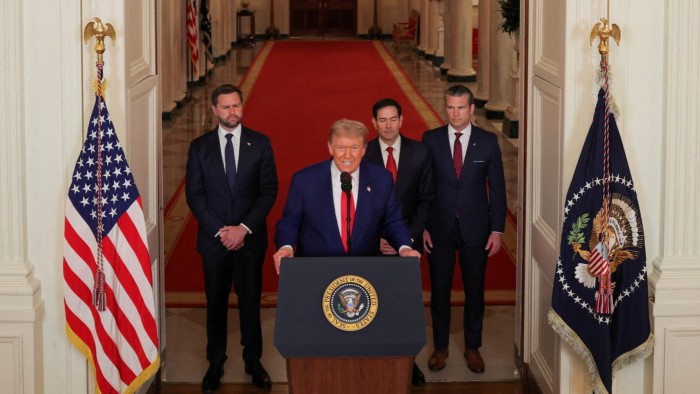Unlock the White House Watch newsletter for free
Your guide to what Trump’s second term means for Washington, business and the world
With his decision to join Israel in striking nuclear sites across Iran on Saturday, Donald Trump has drawn the US into a major war in the Middle East. That he may see the strikes as a limited military operation, rather than a war, and tout its success, does not change the facts: the US has joined Israel’s war on Iran.
American involvement now gives Tehran a justification to strike at energy assets in the Gulf, and US bases and ships across the Middle East, whether it decides to act now or in the future. It also risks drawing the west into what Israel’s Prime Minister Benjamin Netanyahu appears to view as a quest for regime change in Iran. Trump and America have taken a dangerous step into the dark.
The western world has been rightly united in wanting to deprive Iran of developing nuclear weapons and in demanding that Tehran stops its support for radical proxies in the region. But a few weeks of diplomacy by Trump is hardly a credible process to justify military action.
The damage caused by America’s bombing of Iran’s facilities in Fordow, Natanz and Isfahan is surely substantial. But if Tehran still retains some capability or had hidden away some of its stockpiles of highly enriched uranium, it may now rush to develop a nuclear weapon and establish a deterrent.
It is too early to know how Tehran will respond. Israel’s war has shown the Islamic regime’s vulnerabilities, on the defensive as well as offensive fronts. Iran knows that targeting US assets in the region would invite further attacks. Containing its hits to Israel would only prolong a war in which the next target is the regime itself. However strong the urge to strike back, Iran has no good options left. Its leaders would be well advised to step back and not to escalate.
Oil prices are now poised to soar. Investors will be even more concerned that Iran could clog up the Strait of Hormuz — through which a quarter of the world’s seaborne oil trade passes. That said, the regime’s ability and willingness to enforce a blockade are unclear. Whatever happens, the uncertainty surrounding the conflict alone will hamper the global economy.
The risk of mission creep has greatly risen. The Israeli-US strikes might begin a chain of events leading to the downfall of the Islamic regime, yet there is no guarantee that it would be replaced by something more palatable to the US, Israel and the west. It may instead lead to a vacuum. The fear of Iran’s neighbours is that, in a multi-ethnic nation of 90mn, the state could collapse and the country could fragment, in a repeat of the Iraq failure following the US-led invasion in 2003.
The countdown to the US strike started with Trump’s decision in his first term to pull out of the Iran nuclear deal, which severely curbed its nuclear activities. That was an imperfect deal, but Iran was complying. Diplomatic efforts to limit Iran’s nuclear ambitions have always been the best option. The Trump administration has allowed Netanyahu, who has long opposed diplomatic efforts with Tehran, to sideline diplomacy and drag Trump into a war he has wanted for a decade. What the past few weeks have shown is that an unrestrained Israel is also a destabilising force in the region.
The US president has calculated that Iran’s weakness and Israel’s success present a unique opportunity to strike Iran. Perhaps perturbed by suggestions that he does not follow through on his threats, and frustrated by the failures of his peacemaking efforts in Ukraine and the Middle East, he saw a quick win by associating himself with Netanyahu’s mission. But he has also taken a huge gamble, stunning his own isolationist base, and setting the Middle East up for more instability and crisis.
